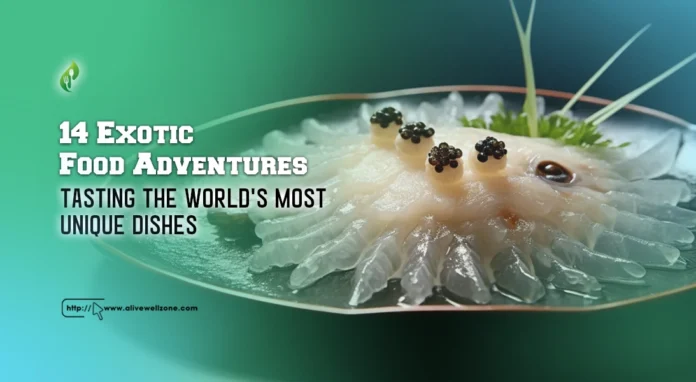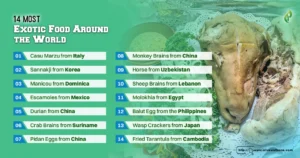Are you tired of the same old flavors? Do you crave something new and exciting to tantalize your taste buds? If so, you’re not alone. Many people are seeking out exotic food experiences to spice up their culinary adventures.
Trying exotic food is not just about satisfying your curiosity; it’s also a way to explore different cultures and learn new things. Globalization makes the world a smaller place, and enjoying diverse cuisine can help you appreciate global diversity.
That’s why, we’ll take you on a flavorful exploration, revealing some of the world’s most fascinating exotic food. Let’s wake up your senses and taste new flavors you’ll love.
14 Most Exotic Food Around the World
Let us introduce you to some of the tastiest and unique foods that have never been tasted before.
1. Casu Marzu from Italy
You can’t imagine anything more shocking than eating the brain of a monkey. In Italy, there’s a dish that might just surprise you. Italian food isn’t just about pizzas, pasta, and gelato. There’s Casu Marzu, a dish that might not appeal to everyone. It’s a sheep’s milk cheese known for containing live insect larvae.
While cheese usually undergoes fermentation, which involves bacteria, Casu Marzu takes it a step further into decomposition. The live larvae are believed to add a distinctive flavor and a soft, creamy texture to the cheese.
However, convincing someone to try a cheese filled with wriggling worms is a challenge, but it’s one that Italians have embraced!
2. Sannakji from Korea
Then there’s Sannakji from Korea, a dish not for the squeamish. Imagine a plate of fresh, live octopus that wriggles as you eat it. When you order Sannakji, which means “live octopus” in Korean, you know exactly what you’re getting into.
The tentacles continue to move on the plate, creating an almost otherworldly scene. Although it might look alive, the tentacles are just reacting to being touched.
Eating Sannakji is a unique experience, with the suction cups on the tentacles sticking to your tongue and a crunchy texture as you bite. With sesame oil and seeds, Sannakji offers a delicious and unique taste experience.
3. Manicou from Dominica
Next up on our journey through the weirdest foods, let’s visit Dominica, a stunning island in the Caribbean. Here, people enjoy a special dish called manicou, also known as agouti in some places. Despite what you might think when you hear “manicou,” it’s not a rodent but a marsupial, similar to an opossum.
Manicou meat is surprisingly tender and tasty, reminiscent of rabbit or venison. People on the island typically grill or stew it, creating a rich and flavorful meal that truly represents Caribbean culinary traditions.
4. Escamoles from Mexico
In Mexico, there’s a unique delicacy known as escamoles, sometimes referred to as “insect caviar” or “Mexican caviar.” Unlike traditional caviar, which consists of fish eggs, escamoles come from the edible larvae of black ants, specifically from the Liometopum apiculatum species.
These small, cream-colored larvae are found at the roots of agave and maguey plants across Mexico. Gathering them is a careful task, involving digging around plant roots to collect the larvae without damaging them.
After being collected, escamoles are cleaned and then cooked, usually by sautéing them in butter with garlic and spices.
Escamoles offer a nutty, slightly buttery taste with an earthy undertone. Their texture is a unique mix of creamy and crunchy, creating a pleasant eating experience. This dish has been part of Mexican cuisine since ancient times, valued highly by pre-Columbian societies.
Today, you can find escamoles in tacos, omelets, and soups, adding a special and exotic touch to Mexican dishes.
5. Durian from China
Durian, often found in China, is known for its unique presence among exotic foods. It might look tempting to try with its appealing appearance, but its smell tells a different story.
This fruit has a powerful odor that many describe as a blend of rotten eggs, vomit, rotting flesh, and sewers. Despite its strong scent, the fruit is quite versatile and can be eaten raw or used in various dishes.
However, its overwhelming smell has led to it being banned in a lot of hotels across Asia and even in airports worldwide.
6. Crab Brains from Suriname
Heading over to Suriname, a country on the northeastern coast of South America, we find another exotic dishes – crab brains. Suriname’s rich culinary traditions include this unusual but highly prized dish.
The process involves carefully removing the brains from crabs and cooking them until they’re creamy and rich. Often served with warm rice or bread, crab brains offer a unique texture and flavor that promises an unforgettable culinary experience.
7. Pidan Eggs from China
China introduces us to pidan eggs, often known as century eggs or thousand-year eggs. These eggs have a striking look that might seem strange at first, but they showcase the creativity of Chinese cooking.
Despite what their name suggests, these eggs aren’t actually aged for centuries. These late night foods are made by coating fresh chicken, duck, or quail eggs in clay, salt, ash, quicklime, and rice straw for weeks to months.
This process changes the egg inside and out. When you open a pidan egg, you’ll find a jelly-like, translucent white that’s turned dark amber or greenish-black.
The yolk inside becomes smooth and creamy, with its consistency varying based on how it’s prepared. Pidan eggs have a distinct taste, with a mix of sulfur and ammonia flavors that might not be for everyone.
8. Monkey Brains from China
Monkey brains are one of the highly debated exotic foods, mainly due to the shocking idea of consuming a monkey’s brain. This food is eaten in China and some other East Asian countries, either cooked with spices or served raw.
It’s controversial because monkeys are high in the food chain and eating their brains could lead to serious ethical concerns. Additionally, there are myths about monkey brains curing certain health problems, but consuming them poses significant health risks instead.
If you’re concerned about your health and weight, try these healthy foods that help you burn fat.
9. Horse from Uzbekistan
Let’s travel to the scenic land of Uzbekistan in Central Asia, where the cuisine is as vibrant as its history. Known for its rich, satisfying dishes like somsas, barak, lagman, and hasib, Uzbekistan’s culinary scene truly stands out.
Among its unique offerings is horse meat, a traditional staple that has been part of Uzbek diets for centuries.
You might find horse meat served in various ways, such as in kebabs, stews, and sausages. There’s also a special dish called norin that features horse meat. If you want something good to eat, remember, this ingredient represents Uzbekistan’s deep-rooted culture.
10. Sheep Brains from Lebanon
In Lebanon, a captivating country in the Middle East, you’ll discover a cuisine known for its bold tastes and varied ingredients. Among these, sheep brains stand out as a signature dish making it one of the exotic dishes.
Eating brains might seem unusual at first, but in Lebanon, sheep brains are a cherished local delicacy. Both locals and adventurous eaters like myself relish it. Cooked with fragrant spices and often paired with warm bread or rice, sheep brains offer a culinary adventure.
Its creamy texture and depth of flavor provide a memorable dining experience, marking it as a standout among exotic foods in Lebanon.
11. Molokhia from Egypt
Molokhia, a traditional Egyptian dish, might first strike you as a green soup with a consistency reminiscent of snot. While its unique texture makes it challenging to present as appetizing, Molokhia is a powerhouse of flavor and antioxidants.
It stands as a staple in not only Egypt but also many Middle Eastern countries. If you can look past its unconventional appearance, prepare to be amazed as you mix it with your rice.
12. Balut Egg from the Philippines
In the Philippines, there’s a unique dish called balut. It’s actually a fertilized duck egg that’s been allowed to develop for a while before being boiled and served.
When you open one, you’ll see a partially developed duck embryo, complete with feathers, beak, and sometimes bones. It’s definitely a shocking view for the uninitiated filled with nutrition and more.
13. Wasp Crackers from Japan
In Japan, there’s a unique snack called Wasp Crackers that might surprise you. Just like it sounds, these crackers contain wasps. The process involves catching wasps, boiling them, drying them out, and then mixing them into the cracker dough.
Think about breaking open a cookie and expecting chocolate chips to find wasps instead! These crackers are quite popular in Japan and are very affordable. Lately, they’ve been gaining attention all around the world.
14. Fried Tarantula from Cambodia
Moving on to Cambodia, where you’ll find fried tarantula, a dish not for the squeamish. Yes, the Thai Zebra Tarantula, as big as a human hand and poisonous in the wild, is a sought-after treat here.
You can find these spiders, fried with a bit of salt and garlic, everywhere from street vendors to upscale restaurants. They’re crispy on the outside and soft on the inside. While most people stick to eating the legs and the head, which are especially crunchy, the more adventurous eaters also try the abdomen.
However, some consider them one of the most unhealthy foods, if not prepared properly.
Some Foods Around the World You Must Try
Traveling the world introduces you to an array of unique dishes —
- In India, Coconut Milk Curry offers a rich taste adventure. This creamy, spice-infused delicacy is a fantastic way to delve into Indian cuisine.
- Thailand’s Pad Thai with Rice Noodles stands as a hallmark of the country’s culinary landscape. This dish brings together stir-fried noodles with a harmonious blend of sweet bean sauce, olive oil, and soy sauce.
- The Mediterranean serves a Lemon-Infused Roasted Chicken that marries succulent chicken with the zesty flavors of lemon and olive oil, creating a dish full of citrusy and savory notes.
- Canada’s Poutine is a hearty treat consisting of fries layered with cheese curds and fried onions, generously covered in savory gravy.
- Malaysia’s Fried Rice Noodles with Curry Sauce is a vibrant offering. Stir-fried noodles in a spicy curry pack a flavorful punch that is both thrilling and fulfilling.
- Vietnam’s Rice Noodle Soup presents a flavor explosion reminiscent of Hanoi’s lively streets, offering a taste that’s as complex as it is comforting.
Conclusion
From Italy’s Casu Marzu to Cambodia’s Fried Tarantula, the list of the world’s most exotic foods reveals an incredibly diverse palette of tastes. Each dish, whether it evokes curiosity or apprehension, stands as a testament to the rich cultural traditions and culinary innovations that define different regions.
We invite you to step outside your comfort zone and explore these unique flavors. There’s no need to rush or feel pressured; start with whatever piques your interest.
And if you’re looking for a truly unique taste experience, why not give each dish a try? Remember, exploring exotic foods is not just about tasting something different; it’s about experiencing the world through its diverse cuisines
FAQs
What’s the most exotic food you’ve tried in the USA?
Across the country, the idea of exotic food varies. Some examples include cow tongue in lengua tacos, frog legs, tripe (cow stomach) in pho, chicken hearts in hot pot, squirrel, venison (deer meat), and pork rinds.
What is exotic food?
Essentially, exotic foods are items not commonly found or native to your own country. They’re the types of foods that don’t usually make it into everyday meals.
Is rabbit exotic food?
In the Philippines, although the Animal Welfare Act permits the humane slaughter of certain animals for food, rabbits aren’t typically eaten. They’re seen as more of an “exotic meat” since they’re not a standard choice for meals.






